great britain
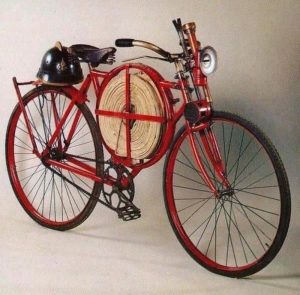 At the turn of the century, some firefighters arrived at the fire in a slightly different way than the normal truck or wagon. I don’t suppose that this was a common practice, because in most cases, it would be impractical, but for the firefighters in the workshops of Birmingham Small Arms in Great Britain, it was the normal mode of transportation. Birmingham Small Arms built a special bicycle for their firefighters. The bicycle would be an interesting way to ride to and from work, as well, but this one was to be used for a very special purpose. I would think that there might have been several businesses like Birmingham Small Arms, that utilized this type of firefighting “truck.”
At the turn of the century, some firefighters arrived at the fire in a slightly different way than the normal truck or wagon. I don’t suppose that this was a common practice, because in most cases, it would be impractical, but for the firefighters in the workshops of Birmingham Small Arms in Great Britain, it was the normal mode of transportation. Birmingham Small Arms built a special bicycle for their firefighters. The bicycle would be an interesting way to ride to and from work, as well, but this one was to be used for a very special purpose. I would think that there might have been several businesses like Birmingham Small Arms, that utilized this type of firefighting “truck.”
The bicycle was equipped with a fire hose that could be hooked up to a hydrant, and a spindle to hold it. It also held a crowbar to get into buildings, and a flashlight so the firefighter could see to get around in the dark. The bicycle wouldn’t be practical in a big city, but for a small town, or a company yard, it was perfect. I can see where it 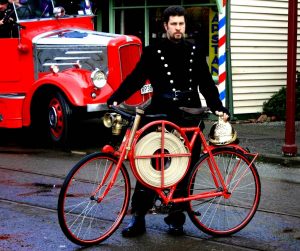 could be problematic if they tried to use the bicycle in the wintertime, but the other season would be ok for the most part.
could be problematic if they tried to use the bicycle in the wintertime, but the other season would be ok for the most part.
Of course, I can see some ways in which the fire bike would not really be the best option. Fire hose has a lot of pressure, and so, would it knock the bicycle over. Also, I’m not sure how wide the firehose spindle is, but it seems to me that it could make peddling difficult. I’m not sure how heavy of how well balanced the bicycle is, but it seems like it might be top heavy. Given the possible problems with the fire bike, I think it might be best to stick with a fire truck. The modern day firetrucks are able to carry lots of other equipment that is necessary to fighting fires. They can also go most places, in all kinds of weather…just a better idea, in the long run.
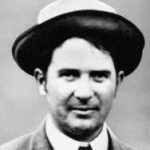
 My niece, Siara Harman is one of many girls who were cheerleaders in high school and college. She even won a State Championship and a Grand National Championship with the Kelly Walsh Cheer Squad in 2011. Since it’s beginnings, cheerleading has come a long way. In fact, I doubt if today’s cheerleaders would recognize their earlier counterparts, if they saw them back then. Siara was a skilled cheerleader, and very athletic, and we are all proud of her cheerleading years.
My niece, Siara Harman is one of many girls who were cheerleaders in high school and college. She even won a State Championship and a Grand National Championship with the Kelly Walsh Cheer Squad in 2011. Since it’s beginnings, cheerleading has come a long way. In fact, I doubt if today’s cheerleaders would recognize their earlier counterparts, if they saw them back then. Siara was a skilled cheerleader, and very athletic, and we are all proud of her cheerleading years.
The roots of American cheerleading are closely tied to American football’s roots. The first intercollegiate football game was played on November 6, 1869, between Princeton University and Rutgers University in New Jersey. By the 1880s, Princeton had formed an pep club. Organized cheering started as an all-male activity, as many sports do. As early as 1877, Princeton University had a Princeton Cheer. Basically, it was a fight song that was documented in the February 22, 1877; March 12, 1880; and November 4, 1881, issues of The Daily Princetonian. This cheer was yelled from the stands by students attending games, as well as by the athletes themselves. The cheer, “Hurrah! Hurrah! Hurrah! Tiger! S-s-s-t! Boom! A-h-h-h!” remains in use with slight modifications today, where it is now referred to as the Locomotive. Princeton class of 1882 graduate Thomas Peebles moved to Minnesota in 1884. He took with him the idea of organized crowds cheering at football games to the University of Minnesota. The term “Cheer Leader” had been used as early as 1897, with Princeton’s football officials having named three students as Cheer Leaders: Thomas, Easton, and Guerin from Princeton’s classes of 1897, 1898, and 1899, respectively, on October 26, 1897. These students would cheer for the team also at football practices, and special cheering sections were designated in the stands for the games themselves for both the home and visiting teams. On November 2, 1898, the University of Minnesota was on a losing streak. A medical student named Johnny Campbell assembled a group to energize the team and the crowd. Johnny picked up a megaphone and rallied the team to victory with the first organized cheer: “Rah, Rah, Rah! Ski-U-Mah! Hoo-Rah! Hoo-Rah! Varsity! Varsity! Minn-e-so-tah!” With that action, Campbell became the first cheerleader in America. Soon after, the University of Minnesota organized a “yell leader” squad of six male students, who still use Campbell’s original cheer today. In 1903, the first cheerleading fraternity, Gamma Sigma, was founded.
In 1923, at the University of Minnesota, women were finally permitted to participate in cheerleading. However, it took time for other schools to follow. In the late 1920s, many school manuals and newspapers that were published still referred to cheerleaders as chap, fellow, and man. Women cheerleaders were overlooked until the 1940s, when collegiate men were drafted for World War II, creating the opportunity for more women to make their way onto sporting event sidelines. As noted by Kieran Scott in Ultimate Cheerleading: “Girls really took over for the first time.” A report written on behalf of cheerleading in 1955 explained that in larger schools, “occasionally boys, as well as, girls are included,” and in smaller schools, “boys can usually find their place in the athletic program, and cheerleading is likely to remain solely a feminine occupation.” During the 1950s, cheerleading in America also increased in popularity. By the 1960s, some began to consider cheerleading too feminine an extracurricular activity for boys, and by the 1970s, girls primarily cheered at public school games. However, this did not stop its growth. Cheerleading could be found at almost every school level across 
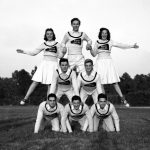 the country, even youth leagues. In 1975, it was estimated by a man named Randy Neil that over 500,000 students actively participated in American cheerleading from grade school to the collegiate level. He also approximated that 95% of cheerleaders within America were female. Since 1973, cheerleaders have started to attend female basketball and other all-female sports as well. As of 2005, overall statistics show around 97% of all modern cheerleading participants are female, although at the collegiate level, cheerleading is co-ed with about 50% of participants being male.
the country, even youth leagues. In 1975, it was estimated by a man named Randy Neil that over 500,000 students actively participated in American cheerleading from grade school to the collegiate level. He also approximated that 95% of cheerleaders within America were female. Since 1973, cheerleaders have started to attend female basketball and other all-female sports as well. As of 2005, overall statistics show around 97% of all modern cheerleading participants are female, although at the collegiate level, cheerleading is co-ed with about 50% of participants being male.

 I think most of us have, at one time or another, watched a car race, be it locally, NASCAR, or maybe even street racing…the illegal kind. We might have even raced some ourselves, because when a kid gets behind the wheel of a car, they tend to want to show off a little bit. I suppose it’s the thrill of the race, and feeling the speed of the car beneath you…whether it’s safe or not. Still, most of us don’t tend to get our cars going as fast as the real racecar drivers do. I don’t know about you, but I think that for most of us, going at some of the NASCAR speeds, in real life, is pretty insane. Those drivers are specially trained, and even then, some have been killed or severely injured in bad crashes during those races. As for me, I think I’ll leave the racing to the professionals.
I think most of us have, at one time or another, watched a car race, be it locally, NASCAR, or maybe even street racing…the illegal kind. We might have even raced some ourselves, because when a kid gets behind the wheel of a car, they tend to want to show off a little bit. I suppose it’s the thrill of the race, and feeling the speed of the car beneath you…whether it’s safe or not. Still, most of us don’t tend to get our cars going as fast as the real racecar drivers do. I don’t know about you, but I think that for most of us, going at some of the NASCAR speeds, in real life, is pretty insane. Those drivers are specially trained, and even then, some have been killed or severely injured in bad crashes during those races. As for me, I think I’ll leave the racing to the professionals.
Not all professionals are what you would expect, however. Yesterday, October 11, 2008 marked a very interesting day in the world of speed. On that day, a speed record was set. A man named Luc Costermans, from Belgium set a world speed record driving 192 miles per hour in a borrowed Lamborghini. What? You are sure the record is much higher than that. Well, you would be right, if we are talking about a sighted driver…but, we are not. Luc Costermans is completely blind!! I’m sure that you were as shocked as I was, but let me tell you that he is not the only blind speed racer. Luc Costermans’ record breaking run was performed on a long, straight stretch of airstrip near Marseilles, France. He was accompanied by a carload of sophisticated navigational equipment, as well as a human co-pilot, who gave directions from the Lamborghini’s passenger seat. How fast would you have to be able to give directions to correct a course error for a blind man traveling at 192 miles per hour? Seriously, I don’t know if the co-pilot was very brave, or simply insane!!
To add to the amazing nature of blind speed racing, Costermans is not the first one, and will not likely be the last. The record Costermans broke belonged to Mike Newman, who was a British driver, and who set his record exactly three years to the day before Costermans. Newman had coaxed his 507 horsepower BMW M5 to a top speed of 178.5 mph. For his part, Newman had smashed a 2 year old record 144.7 mph…that he had set himself in a borrowed Jaguar, just three days after he learned to drive. Unlike Costermans, Newman did not race with a co-pilot or a navigator. Instead, he got his father-in-law to zoom around the track behind him, shouting directions over the radio…what??? My mind was racing by this time. Again came the thought of how fast would his father-in-law have to be talking, and then, the thought that his father-in-law was also driving that fast. Was he a racecar driver too? I can’t imagine my father-in-law would have ever driven that fast. He would have asked me if I was insane.
Both of these blind record-setters are serious competitors who race all sorts of vehicles. In 2001, Newman became the fastest blind motorcycle driver in the world, with a record speed of 89 mph, set just four days after learning to ride. Five years later, Costermans flew a small airplane all around France. He was joined by an 
 instructor and a navigator. Another record-setter, an Englishman named Steve Cunningham, had set the land-speed record himself in 1999, traveling 147 mph, while driving a Chrysler Viper, at the same time that he held the sea-speed record for a blind sailor. In 2004, guided by sophisticated talking navigational software, Cunningham became the first blind pilot to circumnavigate the United Kingdom by air. These men have taken record setting to new levels. I can’t imagine trying these stunts, but then I guess I’m not them.
instructor and a navigator. Another record-setter, an Englishman named Steve Cunningham, had set the land-speed record himself in 1999, traveling 147 mph, while driving a Chrysler Viper, at the same time that he held the sea-speed record for a blind sailor. In 2004, guided by sophisticated talking navigational software, Cunningham became the first blind pilot to circumnavigate the United Kingdom by air. These men have taken record setting to new levels. I can’t imagine trying these stunts, but then I guess I’m not them.

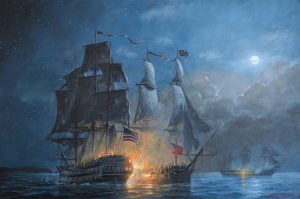 The War of 1812 was a conflict fought between the United States, the United Kingdom and their respective allies. British historians often view the War of 1812 as a minor theater of the Napoleonic Wars, but in the United States and Canada, it is seen as a war in its own right. When the War of 1812 broke out, the British immediately seized control of Lake Erie. They already had a small force of warships there…namely the HMS Queen Charlotte and the HMS Hunter. The HMS Lady Prevost was under construction and was put into service a few weeks after the war’s outbreak. These vessels were controlled by the Provincial Marine…a military transport service, and not part of the British navy. Still, they were there, and at the ready, when the call to war came.
The War of 1812 was a conflict fought between the United States, the United Kingdom and their respective allies. British historians often view the War of 1812 as a minor theater of the Napoleonic Wars, but in the United States and Canada, it is seen as a war in its own right. When the War of 1812 broke out, the British immediately seized control of Lake Erie. They already had a small force of warships there…namely the HMS Queen Charlotte and the HMS Hunter. The HMS Lady Prevost was under construction and was put into service a few weeks after the war’s outbreak. These vessels were controlled by the Provincial Marine…a military transport service, and not part of the British navy. Still, they were there, and at the ready, when the call to war came.
In stark contrast, the Americans lacked any presence to counter the British armed vessels, because the only American warship on Lake Erie, the USS Adams, was not ready for service at the start of the war. When the American army of Brigadier General William Hull abandoned its invasion of Canada, the USS Adams was pinned down in Detroit by the British batteries at Sandwich on the Canadian side of the Detroit River. That left the Americans in a less than favorable position to fight for domination on the lake, and yet they knew it was going to be a necessary battle in the war. In what was going to become the first unqualified defeat of a British naval squadron in history, United States Captain Oliver Hazard Perry lead a fleet of nine American ships to victory over a squadron of six British warships at the Battle of Lake Erie.
The British had taken the USS Adams when Detroit was surrendered, renaming her HMS Detroit. Together with the HMS Caledonia, which had been commandeered from the Canadian North West Company, the ships were boarded and captured near Fort Erie on October 9, 1812, by American sailors and soldiers led by Lieutenant Jesse Elliot. HMS Detroit ran aground on an island in the middle of the Niagara River and was set on fire to prevent recapture. HMS Caledonia was taken to the navy yard at Black Rock and commissioned into the United States Navy. Also present at Black Rock were the USS Somers, USS Ohio, and the USS Trippe, which had all been purchased by the United States Navy and were being converted into gunboats. The British held Fort Erie and the nearby batteries which dominated the Niagara River. All the United States vessels were pinned down and unable to leave Black Rock. The British Major General Isaac Brock used his control of the lake to defeat Hull’s army at the Siege of Detroit, by cutting the American supply lines and rapidly transferring himself and some reinforcements to Amherstburg from where they launched a successful landing on the American side of the Detroit River, but this could not be allowed to continue.
On September 10, 1813, the battle for Lake Erie began. The battle was closely contested for hours, and United States Captain Oliver Hazard Perry’s flagship USS Lawrence was reduced to a defenseless wreck. Perry then transferred to the Niagara and sailed directly into the British line, firing broadsides and forcing the British to 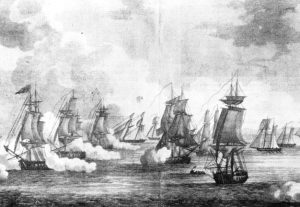
 surrender. Perry had won a complete victory at the cost of 27 Americans killed and 96 wounded. British casualties were 40 dead and 94 wounded. After the battle, Perry sent a famous dispatch to United States General William Henry Harrison that read, “We have met the enemy, and they are ours.” The Battle of Lake Erie forced the British to abandon Detroit, thereby ensuring United States all future control over Lake Erie.
surrender. Perry had won a complete victory at the cost of 27 Americans killed and 96 wounded. British casualties were 40 dead and 94 wounded. After the battle, Perry sent a famous dispatch to United States General William Henry Harrison that read, “We have met the enemy, and they are ours.” The Battle of Lake Erie forced the British to abandon Detroit, thereby ensuring United States all future control over Lake Erie.
 When people first began immigrating to the English Colonies, travel was not easy. In fact, sometimes it was absolutely treacherous. The only way to reach the new world was to travel by ship, and since storms were not able to be predicted far in advance, like they are these days, they sometimes found themselves at the mercy of the raging storm they were caught in. The first person known to have reached Bermuda was the Spanish sea captain Juan de Bermúdez in 1503. The islands are named after him. He claimed the islands for the Spanish Empire. De Bermúdez never landed on the islands, but made two visits to the island chain, and over the course of those visits, he created a recognizable map. I’m sure that at some point, de Bermúdez assumed that there would be people living on the islands, but it was not expected to be quite as soon as it was, or in quite the way that it was populated.
When people first began immigrating to the English Colonies, travel was not easy. In fact, sometimes it was absolutely treacherous. The only way to reach the new world was to travel by ship, and since storms were not able to be predicted far in advance, like they are these days, they sometimes found themselves at the mercy of the raging storm they were caught in. The first person known to have reached Bermuda was the Spanish sea captain Juan de Bermúdez in 1503. The islands are named after him. He claimed the islands for the Spanish Empire. De Bermúdez never landed on the islands, but made two visits to the island chain, and over the course of those visits, he created a recognizable map. I’m sure that at some point, de Bermúdez assumed that there would be people living on the islands, but it was not expected to be quite as soon as it was, or in quite the way that it was populated.
On July 28, 1609, a ship named Sea Ventureran into a reef that surrounds Bermuda during a hurricane. The ship was on its way to Jamestown, Virginia, but would not make it to that destination. The Sea Venture set out for Virginia on June 2, 1609, under the command of Sir George Somers, admiral of the fleet, with Christopher Newport as captain and Sir Thomas Gates, Governor of the colony. Sea Venture sailed with a fleet of ships, including the Falcon, Diamond, Swallow, Unity, Blessing, Lion, and two smaller ships. The ships were only eight days from the coast of Virginia, when they were suddenly caught in a hurricane. The Sea Venture became separated from the rest of the fleet, while its crew fought the storm for three days. Other ships the size of Sea Venture had successfully fought and survived such weather, but the Sea Venture had a one major problem. The Sea Venture was a new ship, and its timbers had not yet set. The storm forced the caulking from between the timbers, and the ship began to leak rapidly. The crew began desperately bailing, but water continued to pour into the hold. The crew threw some of the guns overboard in an effort to make the ship lighter, but this only delayed the inevitable.
The island was owned as an extension of Virginia by the Virginia Company until 1614. Then the Somers Isles Company, took over in 1615 and managed the colony until 1684. At that time, the company’s charter was 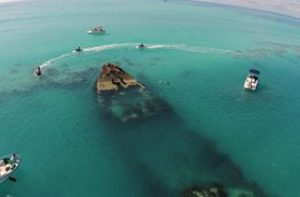 revoked, and England took over administration. Bermuda became a British colony following the 1707 unification of the parliaments of Scotland and England, which created the Kingdom of Great Britain. After 1949, when Newfoundland became part of Canada, Bermuda became the oldest remaining British overseas territory. After the return of Hong Kong to China in 1997, Bermuda became the most populated British territory. Today, Bermuda is a popular vacation spot for many tourists. Cruise ships and planes arrive daily. I’m sure the islands would have eventually been populated, but in the case of Bermuda, it was very much an accidental population, caused by an unfortunate ship wreck that first brought its survivors to the islands.
revoked, and England took over administration. Bermuda became a British colony following the 1707 unification of the parliaments of Scotland and England, which created the Kingdom of Great Britain. After 1949, when Newfoundland became part of Canada, Bermuda became the oldest remaining British overseas territory. After the return of Hong Kong to China in 1997, Bermuda became the most populated British territory. Today, Bermuda is a popular vacation spot for many tourists. Cruise ships and planes arrive daily. I’m sure the islands would have eventually been populated, but in the case of Bermuda, it was very much an accidental population, caused by an unfortunate ship wreck that first brought its survivors to the islands.
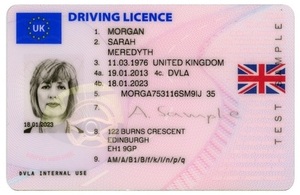 Most people in the United States consider driving a car a right, but in reality it is a privilege, and must be earned. At 15 a child may obtain a permit to drive with a licensed driver by taking a written exam. Then in a year, or at age 16, they have to take a written and driving test to get a license. The driving test can be waived if they have completed driver’s education. The exams are pretty basic, and in this country, most people pass the test on the first try, and if not on the first try, most pass on the second try. The first driving test was administered in 1899 Chicago and New York City. Massachusetts and Missouri were the first US states to require a license for driving a motor vehicle in 1903. Pennsylvania’s 1909 licensing laws were the first to give an age restriction “18 years of age” and the first state to allow 16 year olds to drive, if they were accompanied by a licensed driver, was Connecticut in 1921. I’m sure that prior to these times most people didn’t have one of the new fangled automobiles, so a license was not needed.
Most people in the United States consider driving a car a right, but in reality it is a privilege, and must be earned. At 15 a child may obtain a permit to drive with a licensed driver by taking a written exam. Then in a year, or at age 16, they have to take a written and driving test to get a license. The driving test can be waived if they have completed driver’s education. The exams are pretty basic, and in this country, most people pass the test on the first try, and if not on the first try, most pass on the second try. The first driving test was administered in 1899 Chicago and New York City. Massachusetts and Missouri were the first US states to require a license for driving a motor vehicle in 1903. Pennsylvania’s 1909 licensing laws were the first to give an age restriction “18 years of age” and the first state to allow 16 year olds to drive, if they were accompanied by a licensed driver, was Connecticut in 1921. I’m sure that prior to these times most people didn’t have one of the new fangled automobiles, so a license was not needed.
The United Kingdom made the move to require testing on March 24, 1934, and the requirements were a little different than in the United States. The test must be taken in order to receive a full license, and also to add full entitlements to an existing license. The test varies, depending on the class of vehicle that is to be driven, and is administered by the Driver and Vehicle Standards Agency or DVSA, in Great Britain and the Driver and Vehicle Agency, or DVA in Ireland. Those parts of the program seem to be just like here in the United States, but from there on out, there is a pretty big difference. In the United Kingdom, the minimum age at which one can take a driving test is currently 16 for mopeds and 17 for cars, with an exception allowed at 16 for those on the higher/enhanced rate of the mobility component. In addition to a driving licence, a CBT certificate may be required before a moped or motorcycle is ridden.
In Great Britain around 1.6 million people take the practical car test per year. Approximately 43% of those who take it pass the test, and the theory test has a pass rate of about 51.6%. Now I don’t know what you think, but I think the kids in this country would be pretty upset if only half of those who took the test got to actually drive  legally. Then again, maybe kids would study harder for the test in that case. I can’t tell you how many times I have heard a kid say, “It’s all common sense.” My thought is, “What wealth of knowledge about driving a car is a 15 year old, who has never driven one, going to have.” The answer is obvious…to the parents anyway. If they don’t study, they will likely not pass, but what of the people of Great Britain and Ireland. They know the test is difficult. My guess is that they do study, but that the test is a much more advanced version than those in the United States. Maybe it’s because they want it to be more than just common sense. I’m not saying our tests are too easy…but it’s something to consider when you look at the statistics.
legally. Then again, maybe kids would study harder for the test in that case. I can’t tell you how many times I have heard a kid say, “It’s all common sense.” My thought is, “What wealth of knowledge about driving a car is a 15 year old, who has never driven one, going to have.” The answer is obvious…to the parents anyway. If they don’t study, they will likely not pass, but what of the people of Great Britain and Ireland. They know the test is difficult. My guess is that they do study, but that the test is a much more advanced version than those in the United States. Maybe it’s because they want it to be more than just common sense. I’m not saying our tests are too easy…but it’s something to consider when you look at the statistics.
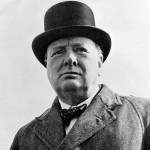 Anytime a battle is waged between good and evil, there is always innuendo. The evil side always tries to deface the good side by calling them warmongers and racists. It doesn’t matter if the evil side is an evil nation, or an evil group within our own country. Whenever the good side tries to take a stand, they are viewed as racist, haters and warmongers. Not much has changed over the years either. If you think all of these accusations are modern day phenomenon, you are wrong. It’s been going on for many years, and has endured to this day.
Anytime a battle is waged between good and evil, there is always innuendo. The evil side always tries to deface the good side by calling them warmongers and racists. It doesn’t matter if the evil side is an evil nation, or an evil group within our own country. Whenever the good side tries to take a stand, they are viewed as racist, haters and warmongers. Not much has changed over the years either. If you think all of these accusations are modern day phenomenon, you are wrong. It’s been going on for many years, and has endured to this day.
On this day, March 5, 1946, former British Prime Minister Winston Spencer Churchill gave a speech condemning the Soviet Union’s policies in Europe and declared, “From Stettin in the Baltic to Trieste in the Adriatic, an iron curtain has descended across the continent.” Many people thought that Churchill’s speech was one of the opening volleys announcing the beginning of the Cold War. After he was defeated for re-election as prime minister of Great Britain in 1945, Churchill was invited to Westminster College in Fulton, Missouri where he gave his speech. President Harry S  Truman joined him on the platform, listening intently to the speech. Churchill praised the United States as well, declaring it stood “at the pinnacle of world power.” Churchill saw the importance of a closer “special relationship” between the United States and Great Britain…the two great powers of the “English-speaking world” in organizing and policing the post World War II world.
Truman joined him on the platform, listening intently to the speech. Churchill praised the United States as well, declaring it stood “at the pinnacle of world power.” Churchill saw the importance of a closer “special relationship” between the United States and Great Britain…the two great powers of the “English-speaking world” in organizing and policing the post World War II world.
Churchill was worried about the expansionistic policies of the Soviet Union. In addition to the “iron curtain” that had descended across Eastern Europe, Churchill spoke of “communist fifth columns” that were operating throughout western and southern Europe. Churchill drew parallels with the disastrous appeasement of Hitler prior to World War II, and advised that in dealing with the Soviets there was “nothing which they admire so much as strength, and there is nothing for which they have less respect than for military weakness.”
Wisely, Truman and other United States officials received the speech in the spirit it was given. They knew that the Soviet Union was bent on expansion, and that they had to stand tough. Churchill’s “iron curtain” phrase 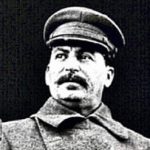 became a part of the official vocabulary of the Cold War era. Some of the United States officials were less than comfortable with the “special relationship” Churchill had spoken of. They knew that the English were valuable allies for the Cold War, they were also aware of Great Britain’s power, and worried about being used a pawns to help support the crumbling British empire. In the Soviet Union, Russian leader Joseph Stalin denounced the speech as “war mongering,” and referred to Churchill’s comments about the “English-speaking world” as imperialist “racism.” The rhetoric never seems to change, does it. The British, Americans, and Russians, all allies against Hitler less than a year before the speech, were drawing the battle lines of the Cold War…and it would be a long 45 year war, lasting from 1946 to 1991.
became a part of the official vocabulary of the Cold War era. Some of the United States officials were less than comfortable with the “special relationship” Churchill had spoken of. They knew that the English were valuable allies for the Cold War, they were also aware of Great Britain’s power, and worried about being used a pawns to help support the crumbling British empire. In the Soviet Union, Russian leader Joseph Stalin denounced the speech as “war mongering,” and referred to Churchill’s comments about the “English-speaking world” as imperialist “racism.” The rhetoric never seems to change, does it. The British, Americans, and Russians, all allies against Hitler less than a year before the speech, were drawing the battle lines of the Cold War…and it would be a long 45 year war, lasting from 1946 to 1991.
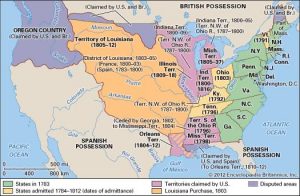 From the time the United States first declared their independence, there was a dispute over the border between the United States and its northern neighbor, Canada. In 1818, the situation finally got to a point whereby a final decision had to be made. It was determined that a convention needed to be held to handle the dispute. The convention, known as the London Convention, Anglo-American Convention of 1818, Convention of 1818, or simply the Treaty of 1818, was to discuss fisheries, boundary and the restoration of slaves between the United States of America and the United Kingdom of Great Britain and Ireland. The Treaty of 1818 was signed during the presidency of James Monroe, and it resolved the boundary between the United States and Canada, then owned by the United Kingdom, once and for all. The treaty allowed for joint occupation and settlement of the Oregon Country, known to the British and in Canadian history as the Columbia District of the Hudson’s Bay Company, and also took in New Caledonia, near Australia.
From the time the United States first declared their independence, there was a dispute over the border between the United States and its northern neighbor, Canada. In 1818, the situation finally got to a point whereby a final decision had to be made. It was determined that a convention needed to be held to handle the dispute. The convention, known as the London Convention, Anglo-American Convention of 1818, Convention of 1818, or simply the Treaty of 1818, was to discuss fisheries, boundary and the restoration of slaves between the United States of America and the United Kingdom of Great Britain and Ireland. The Treaty of 1818 was signed during the presidency of James Monroe, and it resolved the boundary between the United States and Canada, then owned by the United Kingdom, once and for all. The treaty allowed for joint occupation and settlement of the Oregon Country, known to the British and in Canadian history as the Columbia District of the Hudson’s Bay Company, and also took in New Caledonia, near Australia.
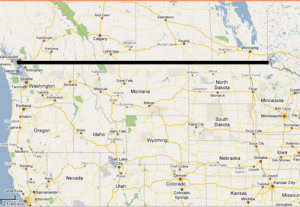
It was ultimately decided that the boundary line should be a straight one, because it would be easier to survey. The prior boundaries were based on watersheds, and were difficult to survey. The treaty marked both the United Kingdom’s last permanent major loss of territory in what is now the Continental United States and the United States’ only permanent significant cession of North American territory to a foreign power. Britain ceded all of Rupert’s Land south of the 49th parallel and west to the Rocky Mountains, including all of the Red River Colony south of that latitude, while the United States ceded the northernmost tip of the territory of Louisiana above the 49th parallel.
 Of course, the prior border from the Great Lakes to the east coast, was already established, so it isn’t straight, but the northwestern border is a straight line. I always thought that was odd, and didn’t know why it was that way. I don’t know if I was not paying attention in history class, which was not my favorite subject in my youth, although I don’t really know why it wasn’t, because now I find it quite fascinating. It’s interesting to find out that the northern border was simply a matter of convenience, and a bit of the barter system, if you will. In order to solve the border war, of sorts, Canada (United Kingdom) gave a little, and the United States gave a little. The end result was a clear cut border, and really, peaceful neighbors. I think the was a good way to settle things.
Of course, the prior border from the Great Lakes to the east coast, was already established, so it isn’t straight, but the northwestern border is a straight line. I always thought that was odd, and didn’t know why it was that way. I don’t know if I was not paying attention in history class, which was not my favorite subject in my youth, although I don’t really know why it wasn’t, because now I find it quite fascinating. It’s interesting to find out that the northern border was simply a matter of convenience, and a bit of the barter system, if you will. In order to solve the border war, of sorts, Canada (United Kingdom) gave a little, and the United States gave a little. The end result was a clear cut border, and really, peaceful neighbors. I think the was a good way to settle things.
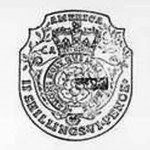 During the years that the colonies were still a part of Great Britain, it was necessary to have troops from Great Britain come and help to defend us during the French and Indian War which took place between 1754 to 1763, and Pontiac’s Rebellion from 1763 to 1764. These were quite costly wars, and to help with recuperate the losses, Great Britain enacted the Sugar Act, which while irritating to the people of the colonies, but it was hidden in the cost of import duties, and so the people accepted it. The enactment of The Stamp Act was a different story, however. The Stamp Act was a tax that Great Britain levied on just the colonies and was strongly disputed. So strongly in fact, that it led to the Revolutionary War.
During the years that the colonies were still a part of Great Britain, it was necessary to have troops from Great Britain come and help to defend us during the French and Indian War which took place between 1754 to 1763, and Pontiac’s Rebellion from 1763 to 1764. These were quite costly wars, and to help with recuperate the losses, Great Britain enacted the Sugar Act, which while irritating to the people of the colonies, but it was hidden in the cost of import duties, and so the people accepted it. The enactment of The Stamp Act was a different story, however. The Stamp Act was a tax that Great Britain levied on just the colonies and was strongly disputed. So strongly in fact, that it led to the Revolutionary War.
The Stamp Act was not what people might think it was. It was not when the use of postage stamps were first introduced. The Stamp Act went so much further than that. The Stamp Act was designed to force colonists to use special stamped paper in the printing of newspapers, pamphlets, almanacs, and playing cards, and to have a stamp embossed on all commercial and legal papers. The stamp itself displayed an image of a Tudor rose framed by the word “America” and the French phrase Honi soit qui mal y pense, meaning ”Shame to him who thinks evil of it.” Of course, the cost of said paper was high, and the colonists ere outraged. This was taxation, without representation, and it was not going to be tolerated.
Massachusetts politician Samuel Adams organized the secret Sons of Liberty organization. They planned protests against the measure, and the Virginia legislature and other colonial assemblies passed resolutions opposing the act. In October, nine colonies sent representatives to New York to attend a Stamp Act Congress, where resolutions of “rights and grievances” were framed and sent to Parliament and King George III. Their voices landed on deaf ears, and The Stamp Act was enacted on this day, November 1, 1765.
The colonists acted quickly. The arrival of the stamps to stamp the paper brought violence and economic retaliation. The colonists began a general boycott of British goods. The Sons of Liberty staged attacks on the customhouses and homes of tax collectors in Boston. The protests and economic turmoil went on for months. Finally, Benjamin Franklin appealed to the British House of Commons. Parliament took a vote, and they repealed The Stamp Act in March 1766. The same day, they made the mistake of passing Declaratory Acts, stating that the British government had free and total legislative power over the colonies.
This would prove to be their downfall. Parliament attempted to force unpopular taxation measures on the American colonies in the late 1760s. This action lead to a steady, and eventually complete, deterioration in British-American relations that brought about the outbreak of the American Revolution in 1775, and the eventual Declaration of Independence of America from Great Britain. It was a hard lesson for Great Britain to  learn, and on that some political parties, namely the Democrats have not learned yet. When you tax the people too heavily, they will rebel, and the outcome will not be in the favor of that abusive government. If taxes are lower, the country will grow. Entrepreneurs will begin new ventures, and the country will prosper, and with prosperity, comes the natural process of more money to run the government. Ours is a nation of independent thinkers, and people of action. Taxes that are too high and unfair, stifle that independent thinking and slow down that action. It is just the opposite of what the proponents of a grossly obese government would expect, but it is nevertheless, the way it works. Our government would do well to realize that, and make a change.
learn, and on that some political parties, namely the Democrats have not learned yet. When you tax the people too heavily, they will rebel, and the outcome will not be in the favor of that abusive government. If taxes are lower, the country will grow. Entrepreneurs will begin new ventures, and the country will prosper, and with prosperity, comes the natural process of more money to run the government. Ours is a nation of independent thinkers, and people of action. Taxes that are too high and unfair, stifle that independent thinking and slow down that action. It is just the opposite of what the proponents of a grossly obese government would expect, but it is nevertheless, the way it works. Our government would do well to realize that, and make a change.
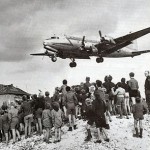 I think that every nation has opportunities to do what can be labeled as defining moments…situations when the nation dealt with an enemy or situation so well, that it can only be considered amazing. That was how the United States reacted to one of the most dramatic standoffs in the history of the Cold War. The Soviet Union decided to block off all road and rail traffic to and from West Berlin, Germany. The move was designed to basically starve the people into submission…or at least that was the plan. It was also a move that would be in defiance to all the other allies in Germany at the time. Unfortunately for the Soviet Union, the blockade turned out to be a horrible diplomatic move, but for the United States, it became a defining moment. The United States emerged from the confrontation with a renewed purpose and confidence, as well as a reputation for being a humanitarian nation.
I think that every nation has opportunities to do what can be labeled as defining moments…situations when the nation dealt with an enemy or situation so well, that it can only be considered amazing. That was how the United States reacted to one of the most dramatic standoffs in the history of the Cold War. The Soviet Union decided to block off all road and rail traffic to and from West Berlin, Germany. The move was designed to basically starve the people into submission…or at least that was the plan. It was also a move that would be in defiance to all the other allies in Germany at the time. Unfortunately for the Soviet Union, the blockade turned out to be a horrible diplomatic move, but for the United States, it became a defining moment. The United States emerged from the confrontation with a renewed purpose and confidence, as well as a reputation for being a humanitarian nation.
When World War II ended, Germany was divided into occupation zones. The United States, Great Britain, the Soviet Union, and eventually France were granted specific zones to occupy. Each nation was there to accept the surrender of Nazi forces and restore order. The Soviet Union occupied most of eastern Germany, and the other 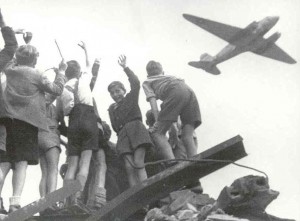 Allied nations occupied western Germany. The German capital of Berlin was divided into four sections as well. The differences between the United States and the Soviet Union were immediately evident. The Soviets were intent on thoroughly breaking the Germans…making them neutral and disarmed. Punishment was going to be at the top of the list. The United States saw things differently. They believed that the economic recovery of Western Europe depended of a strong, reunified Germany. The United States also felt that a rearmed Germany was going to be a stiff deterrent to further Soviet expansion into Western Europe. In May 1946, the Americans stopped reparations shipments from their zone to the Soviets. In December, the British and Americans combined their zones; the French joined some months later. The Soviets viewed these actions as a threat and issued more demands for more say in the economic future of Germany. On June 22, 1948, negotiations between the Soviets, Americans, and British broke down. On June 24, Soviet forces blocked the roads and railroad lines into West Berlin.
Allied nations occupied western Germany. The German capital of Berlin was divided into four sections as well. The differences between the United States and the Soviet Union were immediately evident. The Soviets were intent on thoroughly breaking the Germans…making them neutral and disarmed. Punishment was going to be at the top of the list. The United States saw things differently. They believed that the economic recovery of Western Europe depended of a strong, reunified Germany. The United States also felt that a rearmed Germany was going to be a stiff deterrent to further Soviet expansion into Western Europe. In May 1946, the Americans stopped reparations shipments from their zone to the Soviets. In December, the British and Americans combined their zones; the French joined some months later. The Soviets viewed these actions as a threat and issued more demands for more say in the economic future of Germany. On June 22, 1948, negotiations between the Soviets, Americans, and British broke down. On June 24, Soviet forces blocked the roads and railroad lines into West Berlin.
When the Soviets blocked the roads and railways, the Americans were furious. The question now became, what to do about it. Inside West Berlin there was panic. The people thought they were going to die. For a few tense 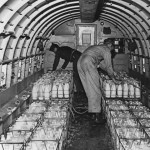 days, the world waited to see what the United States would do next. Then, just two days after the Soviets began the blockade, the United States reacted in a way that was so unexpected, and in the end, it would be a way that brought about that defining moment, and really set the stage for the humanitarian reputation the United States has today. A massive airlift of supplies was sent into West Berlin in what would become one of the greatest logistical efforts in history. For the Soviets, the escapade quickly became a diplomatic embarrassment. They looked like an international bully that was trying to starve men, women, and children into submission. The successful American airlift merely served to accentuate the technological superiority of the United States over the Soviet Union. On May 12, 1949, the Soviets officially ended the blockade.
days, the world waited to see what the United States would do next. Then, just two days after the Soviets began the blockade, the United States reacted in a way that was so unexpected, and in the end, it would be a way that brought about that defining moment, and really set the stage for the humanitarian reputation the United States has today. A massive airlift of supplies was sent into West Berlin in what would become one of the greatest logistical efforts in history. For the Soviets, the escapade quickly became a diplomatic embarrassment. They looked like an international bully that was trying to starve men, women, and children into submission. The successful American airlift merely served to accentuate the technological superiority of the United States over the Soviet Union. On May 12, 1949, the Soviets officially ended the blockade.

